BEA111 Assignment: Climate Change and Economics Briefing Note
VerifiedAdded on 2023/01/16
|6
|956
|85
Report
AI Summary
This ministerial briefing note analyzes the economic consequences of climate change on Australia, focusing on fisheries and aquaculture, and wheat production. The report examines the microeconomic impacts, such as changes in demand and supply, price fluctuations, and welfare effects, alongside macroeconomic impacts on GDP, inflation, and unemployment. The analysis highlights how rising temperatures affect fisheries' habitats, reducing demand and supply, and impacting GDP components. Similarly, the report details how reduced wheat production, due to climate change, increases prices and influences GDP, inflation, and employment. The briefing concludes by emphasizing the importance of controlling global warming to maintain economic stability.
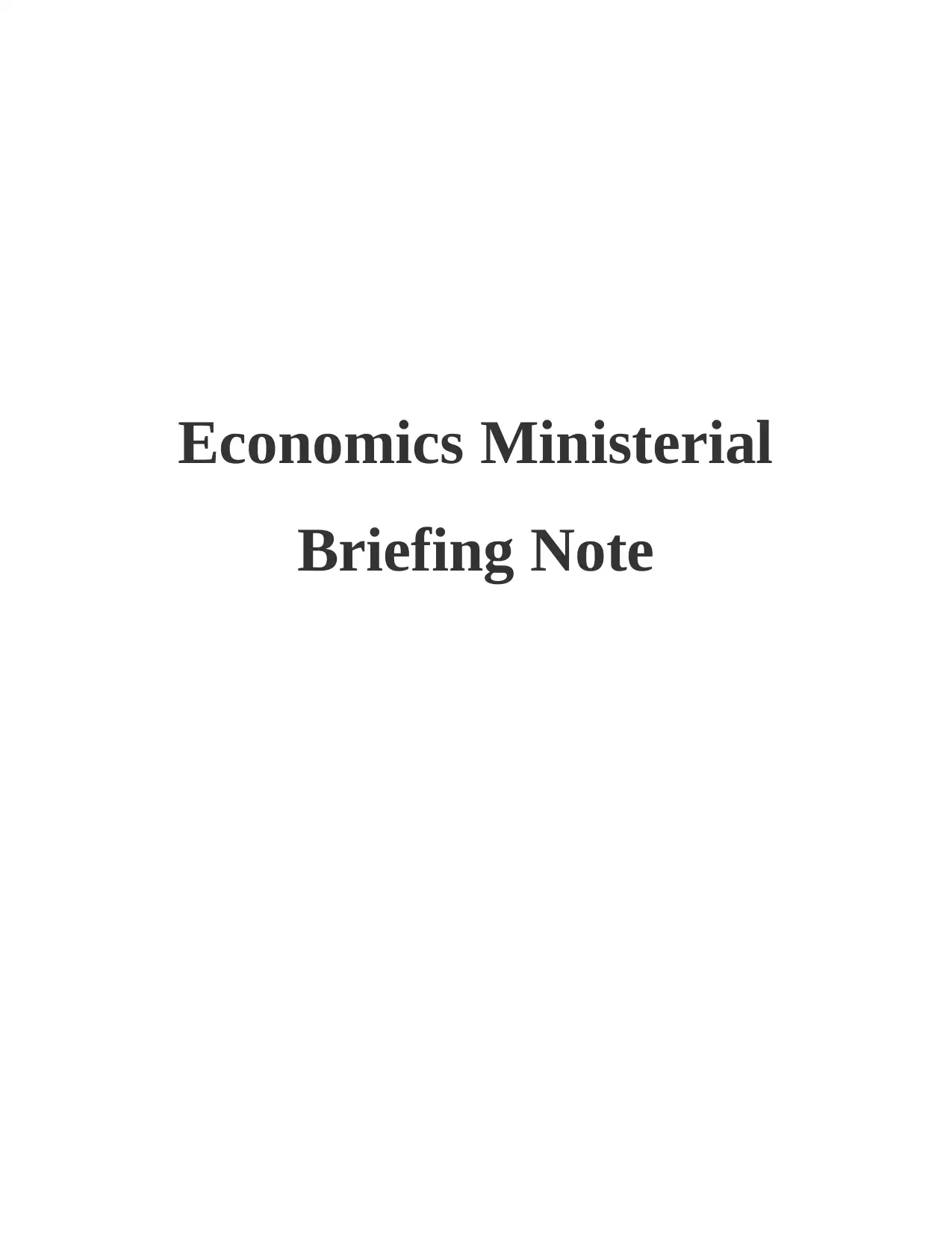
Economics Ministerial
Briefing Note
Briefing Note
Paraphrase This Document
Need a fresh take? Get an instant paraphrase of this document with our AI Paraphraser
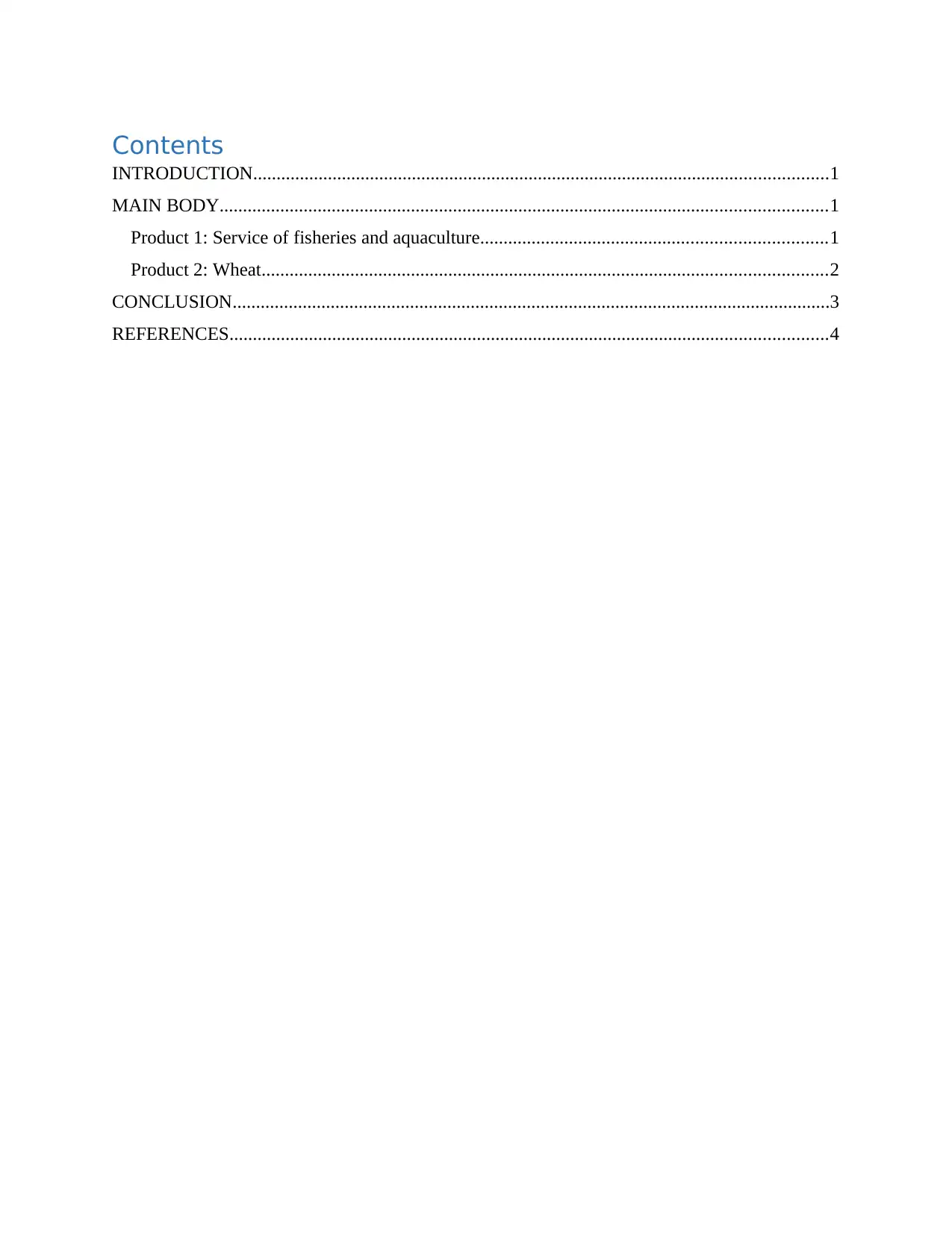
Contents
INTRODUCTION...........................................................................................................................1
MAIN BODY..................................................................................................................................1
Product 1: Service of fisheries and aquaculture..........................................................................1
Product 2: Wheat.........................................................................................................................2
CONCLUSION................................................................................................................................3
REFERENCES................................................................................................................................4
INTRODUCTION...........................................................................................................................1
MAIN BODY..................................................................................................................................1
Product 1: Service of fisheries and aquaculture..........................................................................1
Product 2: Wheat.........................................................................................................................2
CONCLUSION................................................................................................................................3
REFERENCES................................................................................................................................4
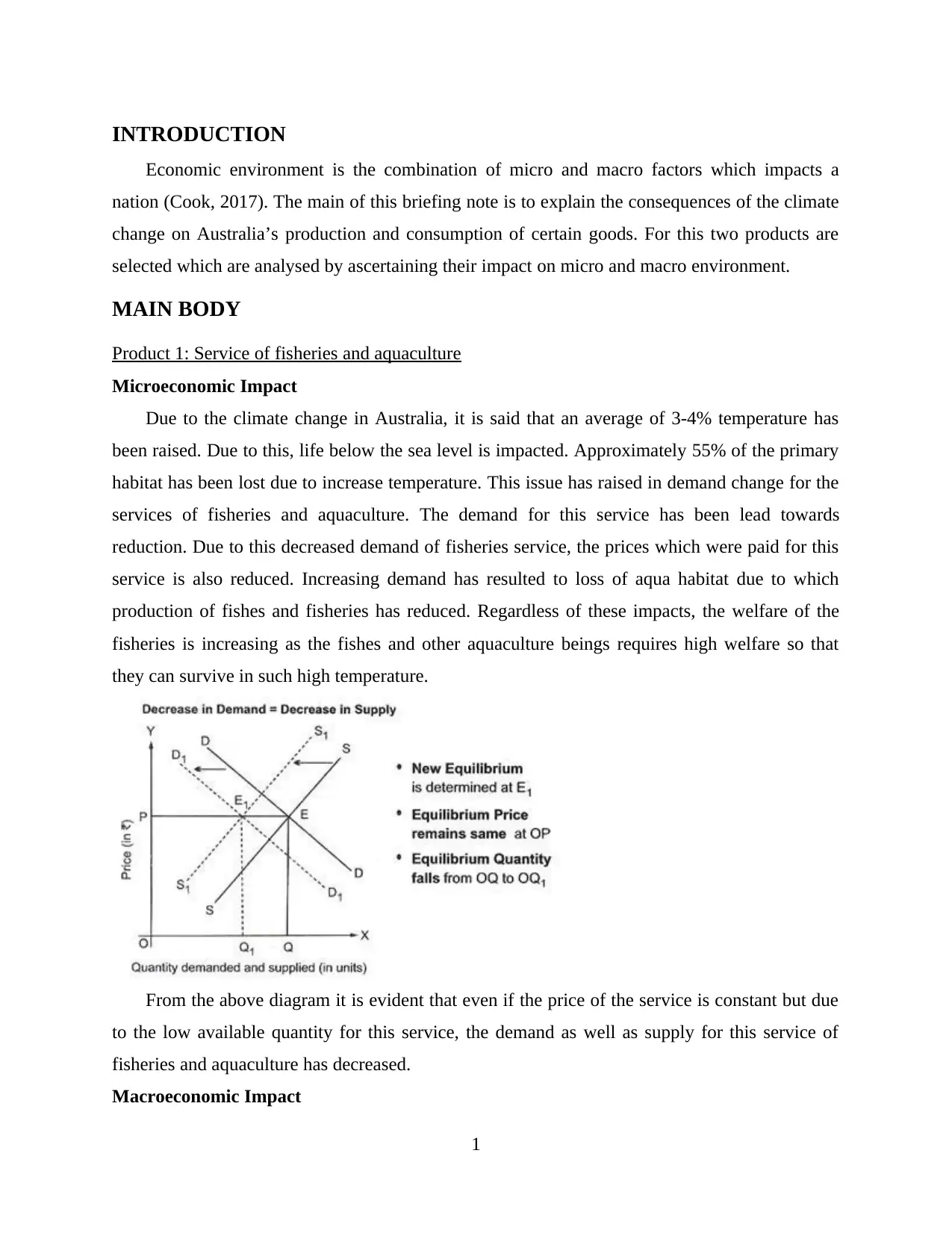
INTRODUCTION
Economic environment is the combination of micro and macro factors which impacts a
nation (Cook, 2017). The main of this briefing note is to explain the consequences of the climate
change on Australia’s production and consumption of certain goods. For this two products are
selected which are analysed by ascertaining their impact on micro and macro environment.
MAIN BODY
Product 1: Service of fisheries and aquaculture
Microeconomic Impact
Due to the climate change in Australia, it is said that an average of 3-4% temperature has
been raised. Due to this, life below the sea level is impacted. Approximately 55% of the primary
habitat has been lost due to increase temperature. This issue has raised in demand change for the
services of fisheries and aquaculture. The demand for this service has been lead towards
reduction. Due to this decreased demand of fisheries service, the prices which were paid for this
service is also reduced. Increasing demand has resulted to loss of aqua habitat due to which
production of fishes and fisheries has reduced. Regardless of these impacts, the welfare of the
fisheries is increasing as the fishes and other aquaculture beings requires high welfare so that
they can survive in such high temperature.
From the above diagram it is evident that even if the price of the service is constant but due
to the low available quantity for this service, the demand as well as supply for this service of
fisheries and aquaculture has decreased.
Macroeconomic Impact
1
Economic environment is the combination of micro and macro factors which impacts a
nation (Cook, 2017). The main of this briefing note is to explain the consequences of the climate
change on Australia’s production and consumption of certain goods. For this two products are
selected which are analysed by ascertaining their impact on micro and macro environment.
MAIN BODY
Product 1: Service of fisheries and aquaculture
Microeconomic Impact
Due to the climate change in Australia, it is said that an average of 3-4% temperature has
been raised. Due to this, life below the sea level is impacted. Approximately 55% of the primary
habitat has been lost due to increase temperature. This issue has raised in demand change for the
services of fisheries and aquaculture. The demand for this service has been lead towards
reduction. Due to this decreased demand of fisheries service, the prices which were paid for this
service is also reduced. Increasing demand has resulted to loss of aqua habitat due to which
production of fishes and fisheries has reduced. Regardless of these impacts, the welfare of the
fisheries is increasing as the fishes and other aquaculture beings requires high welfare so that
they can survive in such high temperature.
From the above diagram it is evident that even if the price of the service is constant but due
to the low available quantity for this service, the demand as well as supply for this service of
fisheries and aquaculture has decreased.
Macroeconomic Impact
1
⊘ This is a preview!⊘
Do you want full access?
Subscribe today to unlock all pages.

Trusted by 1+ million students worldwide
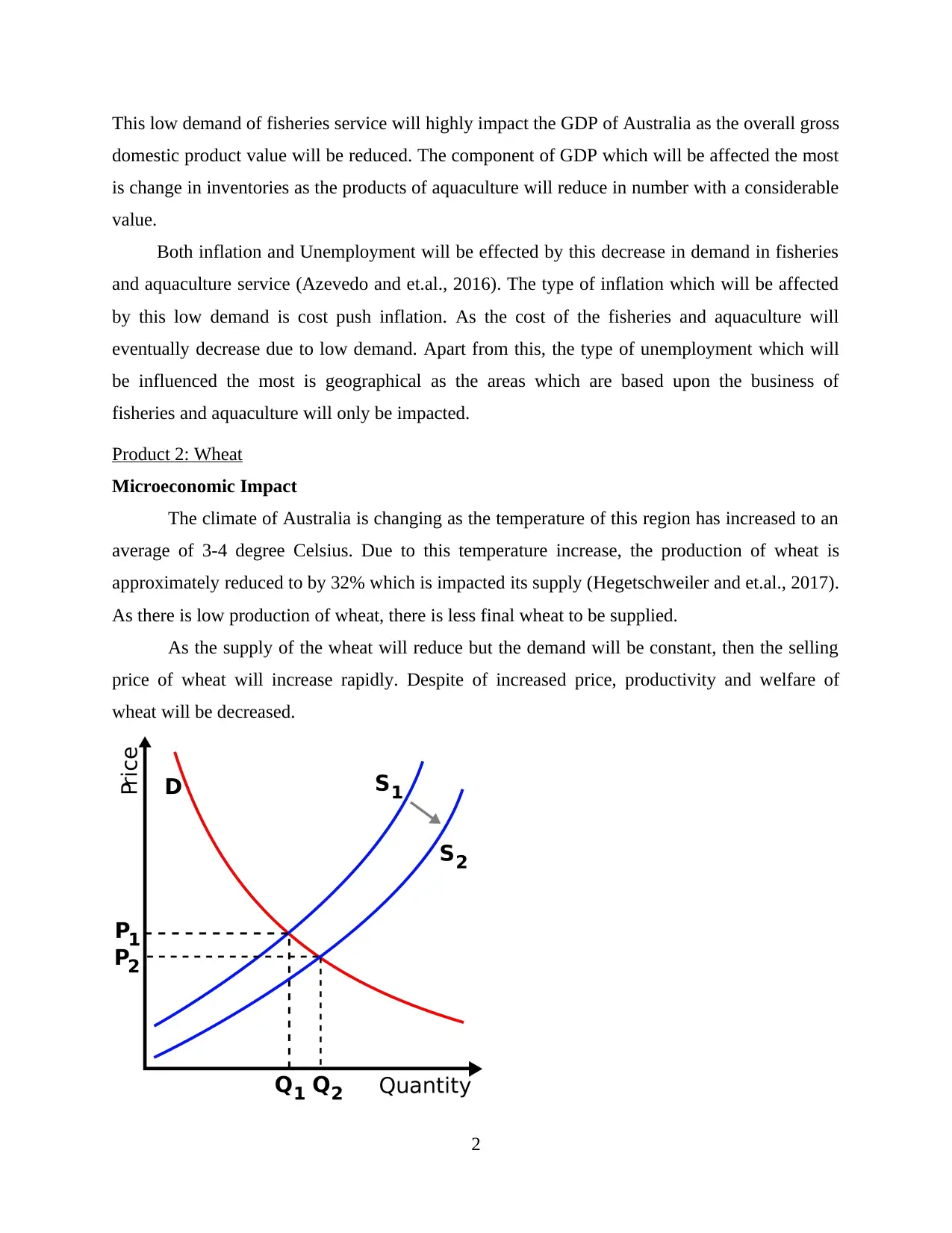
This low demand of fisheries service will highly impact the GDP of Australia as the overall gross
domestic product value will be reduced. The component of GDP which will be affected the most
is change in inventories as the products of aquaculture will reduce in number with a considerable
value.
Both inflation and Unemployment will be effected by this decrease in demand in fisheries
and aquaculture service (Azevedo and et.al., 2016). The type of inflation which will be affected
by this low demand is cost push inflation. As the cost of the fisheries and aquaculture will
eventually decrease due to low demand. Apart from this, the type of unemployment which will
be influenced the most is geographical as the areas which are based upon the business of
fisheries and aquaculture will only be impacted.
Product 2: Wheat
Microeconomic Impact
The climate of Australia is changing as the temperature of this region has increased to an
average of 3-4 degree Celsius. Due to this temperature increase, the production of wheat is
approximately reduced to by 32% which is impacted its supply (Hegetschweiler and et.al., 2017).
As there is low production of wheat, there is less final wheat to be supplied.
As the supply of the wheat will reduce but the demand will be constant, then the selling
price of wheat will increase rapidly. Despite of increased price, productivity and welfare of
wheat will be decreased.
2
domestic product value will be reduced. The component of GDP which will be affected the most
is change in inventories as the products of aquaculture will reduce in number with a considerable
value.
Both inflation and Unemployment will be effected by this decrease in demand in fisheries
and aquaculture service (Azevedo and et.al., 2016). The type of inflation which will be affected
by this low demand is cost push inflation. As the cost of the fisheries and aquaculture will
eventually decrease due to low demand. Apart from this, the type of unemployment which will
be influenced the most is geographical as the areas which are based upon the business of
fisheries and aquaculture will only be impacted.
Product 2: Wheat
Microeconomic Impact
The climate of Australia is changing as the temperature of this region has increased to an
average of 3-4 degree Celsius. Due to this temperature increase, the production of wheat is
approximately reduced to by 32% which is impacted its supply (Hegetschweiler and et.al., 2017).
As there is low production of wheat, there is less final wheat to be supplied.
As the supply of the wheat will reduce but the demand will be constant, then the selling
price of wheat will increase rapidly. Despite of increased price, productivity and welfare of
wheat will be decreased.
2
Paraphrase This Document
Need a fresh take? Get an instant paraphrase of this document with our AI Paraphraser
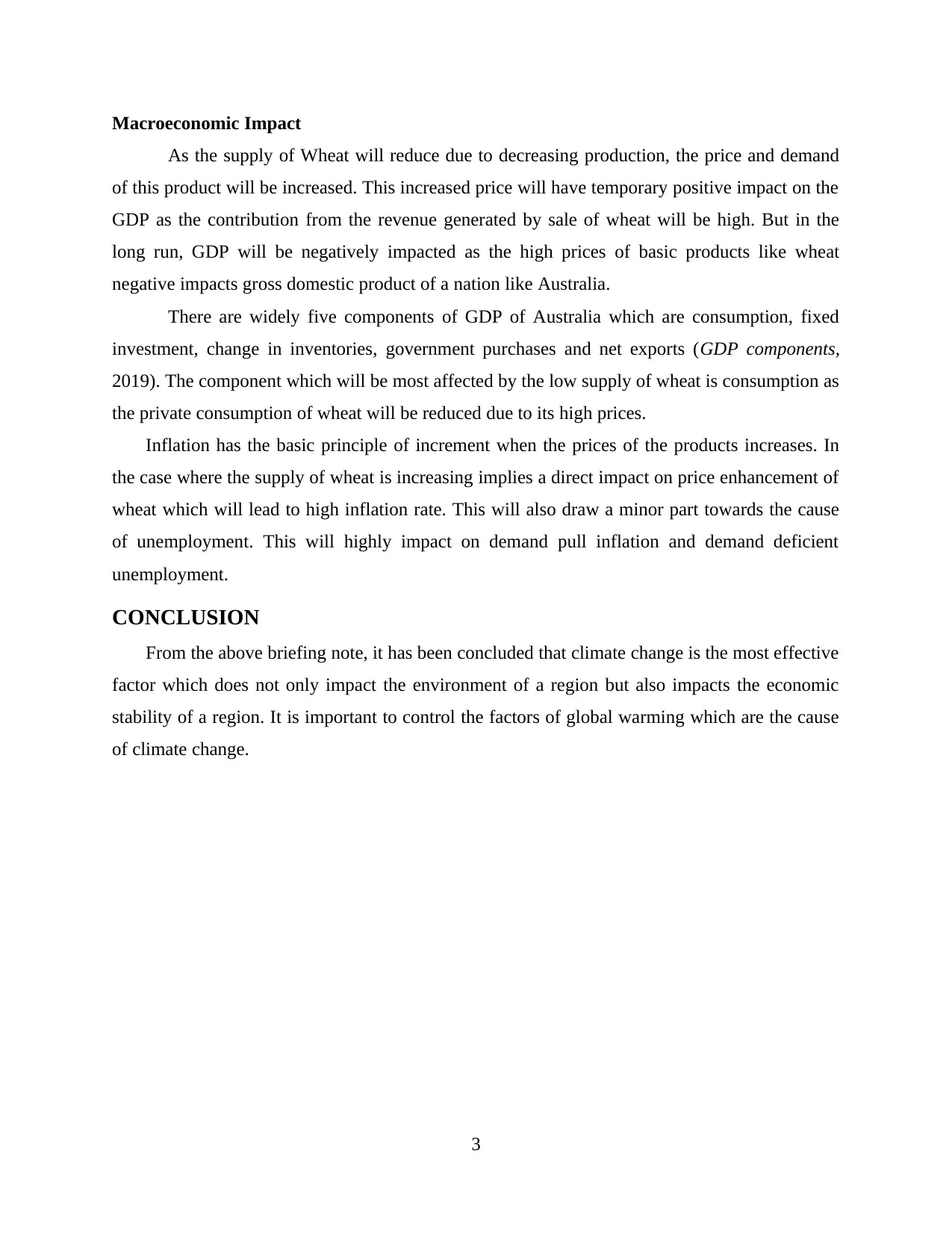
Macroeconomic Impact
As the supply of Wheat will reduce due to decreasing production, the price and demand
of this product will be increased. This increased price will have temporary positive impact on the
GDP as the contribution from the revenue generated by sale of wheat will be high. But in the
long run, GDP will be negatively impacted as the high prices of basic products like wheat
negative impacts gross domestic product of a nation like Australia.
There are widely five components of GDP of Australia which are consumption, fixed
investment, change in inventories, government purchases and net exports (GDP components,
2019). The component which will be most affected by the low supply of wheat is consumption as
the private consumption of wheat will be reduced due to its high prices.
Inflation has the basic principle of increment when the prices of the products increases. In
the case where the supply of wheat is increasing implies a direct impact on price enhancement of
wheat which will lead to high inflation rate. This will also draw a minor part towards the cause
of unemployment. This will highly impact on demand pull inflation and demand deficient
unemployment.
CONCLUSION
From the above briefing note, it has been concluded that climate change is the most effective
factor which does not only impact the environment of a region but also impacts the economic
stability of a region. It is important to control the factors of global warming which are the cause
of climate change.
3
As the supply of Wheat will reduce due to decreasing production, the price and demand
of this product will be increased. This increased price will have temporary positive impact on the
GDP as the contribution from the revenue generated by sale of wheat will be high. But in the
long run, GDP will be negatively impacted as the high prices of basic products like wheat
negative impacts gross domestic product of a nation like Australia.
There are widely five components of GDP of Australia which are consumption, fixed
investment, change in inventories, government purchases and net exports (GDP components,
2019). The component which will be most affected by the low supply of wheat is consumption as
the private consumption of wheat will be reduced due to its high prices.
Inflation has the basic principle of increment when the prices of the products increases. In
the case where the supply of wheat is increasing implies a direct impact on price enhancement of
wheat which will lead to high inflation rate. This will also draw a minor part towards the cause
of unemployment. This will highly impact on demand pull inflation and demand deficient
unemployment.
CONCLUSION
From the above briefing note, it has been concluded that climate change is the most effective
factor which does not only impact the environment of a region but also impacts the economic
stability of a region. It is important to control the factors of global warming which are the cause
of climate change.
3
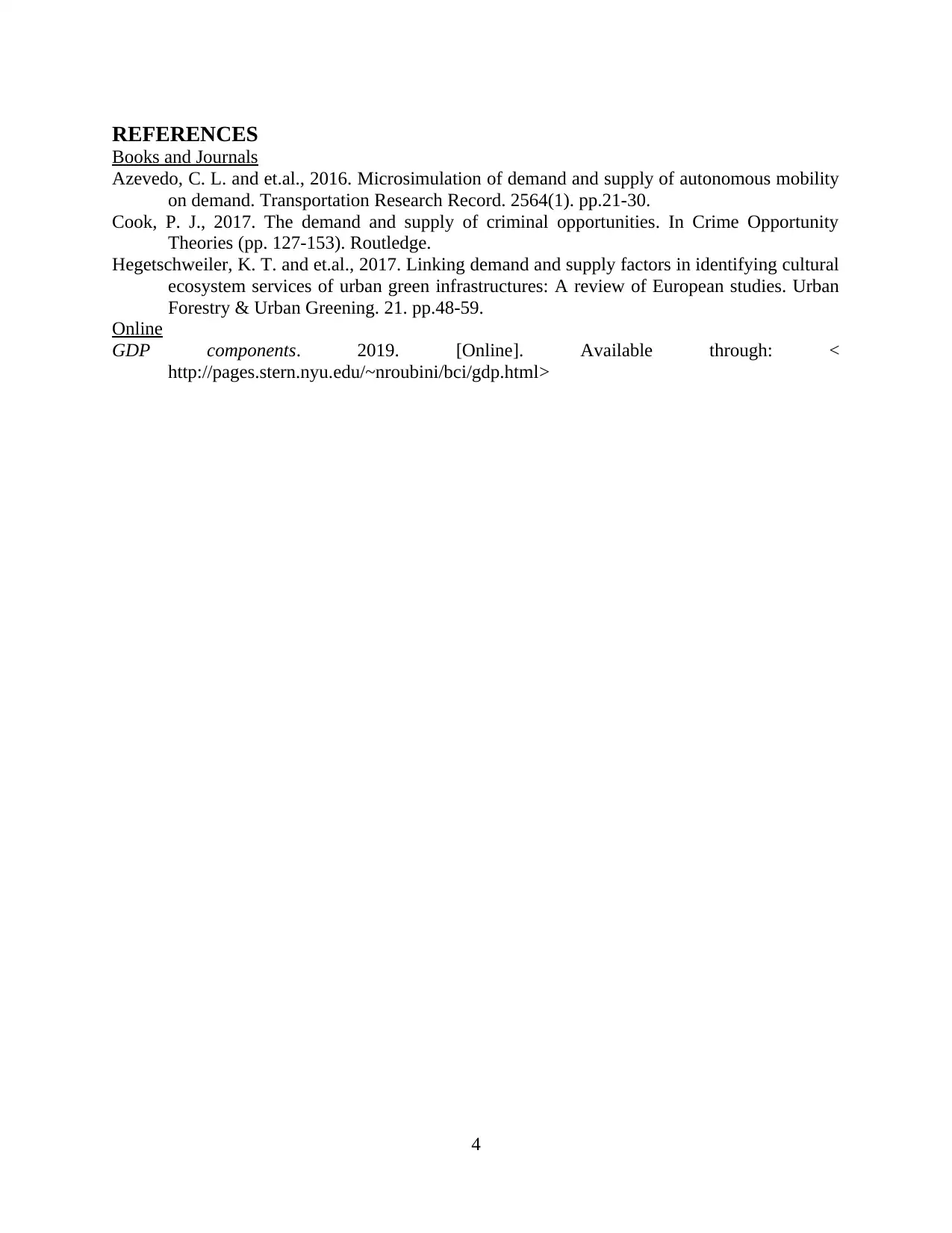
REFERENCES
Books and Journals
Azevedo, C. L. and et.al., 2016. Microsimulation of demand and supply of autonomous mobility
on demand. Transportation Research Record. 2564(1). pp.21-30.
Cook, P. J., 2017. The demand and supply of criminal opportunities. In Crime Opportunity
Theories (pp. 127-153). Routledge.
Hegetschweiler, K. T. and et.al., 2017. Linking demand and supply factors in identifying cultural
ecosystem services of urban green infrastructures: A review of European studies. Urban
Forestry & Urban Greening. 21. pp.48-59.
Online
GDP components. 2019. [Online]. Available through: <
http://pages.stern.nyu.edu/~nroubini/bci/gdp.html>
4
Books and Journals
Azevedo, C. L. and et.al., 2016. Microsimulation of demand and supply of autonomous mobility
on demand. Transportation Research Record. 2564(1). pp.21-30.
Cook, P. J., 2017. The demand and supply of criminal opportunities. In Crime Opportunity
Theories (pp. 127-153). Routledge.
Hegetschweiler, K. T. and et.al., 2017. Linking demand and supply factors in identifying cultural
ecosystem services of urban green infrastructures: A review of European studies. Urban
Forestry & Urban Greening. 21. pp.48-59.
Online
GDP components. 2019. [Online]. Available through: <
http://pages.stern.nyu.edu/~nroubini/bci/gdp.html>
4
⊘ This is a preview!⊘
Do you want full access?
Subscribe today to unlock all pages.

Trusted by 1+ million students worldwide
1 out of 6
Related Documents
Your All-in-One AI-Powered Toolkit for Academic Success.
+13062052269
info@desklib.com
Available 24*7 on WhatsApp / Email
![[object Object]](/_next/static/media/star-bottom.7253800d.svg)
Unlock your academic potential
Copyright © 2020–2025 A2Z Services. All Rights Reserved. Developed and managed by ZUCOL.





